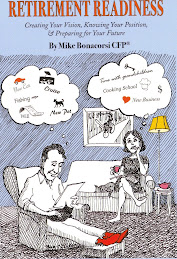At 45 years old, after 15 years at her current job, Mary received a notice that her employer was discontinuing it's defined benefit pension plan. She would not lose the accumulated value up to this point however, the company would no longer be contributing to the plan. This meant that Mary and the other employees were now wholly responsible for funding their retirement.
Mary had counted on that pension; the expense of raising a family, managing a household, and saving for college made it difficult for her and her husband Joe to commit money towards their retirement. They had hoped Mary's pension income along with Social Security, the small amount of savings in their 401k, and part-time work would cover their expenses during retirement. Would they have to work forever just to pay their bills? What would happen if they ran out of savings, or felt they were no longer able to work?
The defined benefit pension provides a benefit at retirement; an ongoing stream of income, often based on a formula of compensation and length of employment. The employer funds the plan, calculated to determine the amount needed to provide the benefit. Several options for distribution are usually available including a single life distribution that ends at the death of the pensioner or a survivorship option that provides a reduced benefit that continues through the lifetime of the surviving spouse.
The income is usually a percentage of actual compensation during the years of employment. Some plans have cost-of-living adjustments to safeguard against rising costs while others are vulnerable to the loss of purchasing power caused by inflation. Personal savings, IRA's and 401k's are still important to help fill the gaps between income and expenses, as well as providing for lump sum withdrawals and emergency resources.
The responsibility of making sure the plan benefit is available at retirement is the responsibility of the employer. The value of the plan is subject to periodic review by an actuary to ensure it is on track to meet the obligations. During prosperous times with strong investment performance, the plan might become over funded, exceeding the obligations due. Other times, poor performance could cause the plan to become underfunded. The employer would be responsible for bringing it back to funded status.
During the 1990’s a shift began to occur regarding retirement benefits provided by employers. The costs of funding and the complicated administration caused many employers to begin freezing these plans and offering only defined contribution (401k) plans. These plans do not provide a defined benefit, it is unknown; only the contribution has a value. Investment performance and contributions determine the plan value; it may be more or less than the contributions at any time, including retirement.
By making the move from a defined benefit plan to a defined contribution plan the security of a no-cost continuous income stream escapes us. The responsibility of funding retirement moves from the employer to the employee. The employee makes pre-tax contributions to the plan through payroll deductions and directs it to the investment sub-accounts offered. The employer may or may not choose to contribute to the plan.
There is much discussion at this time concerning new retirement options; the decline of the pension, concerns about the longevity of Social Security, and the cyclical market declines will require us to be pro-active towards our retirement. Working longer, saving throughout our career and more employee education concerning retirement planning are steps in the right direction.

Two Minute Retirement Readiness Tips
Thursday, June 25, 2009
Working Without a Net-The Disappearing Pension
Labels:
advice,
baby boomer,
books,
expert advice,
finance,
income,
money,
retirement,
Retirement Readiness,
social security

